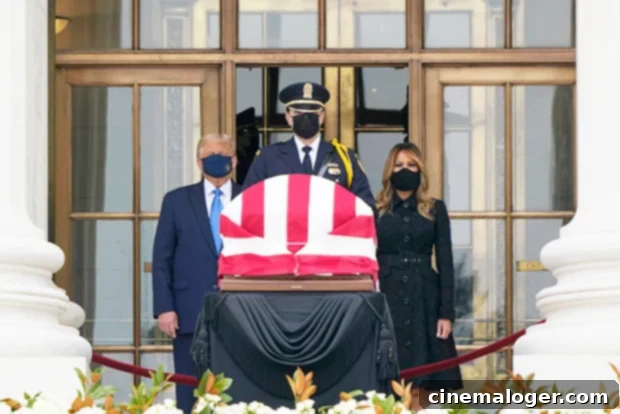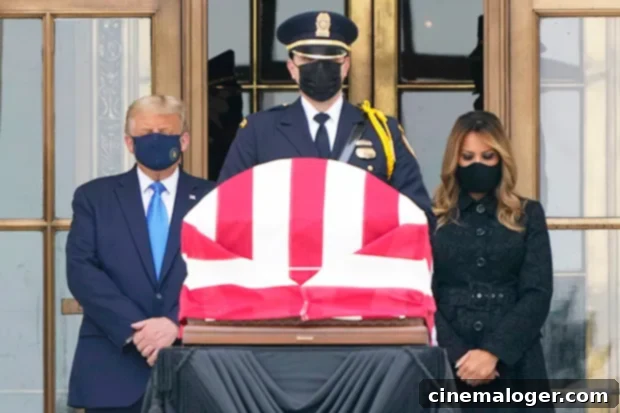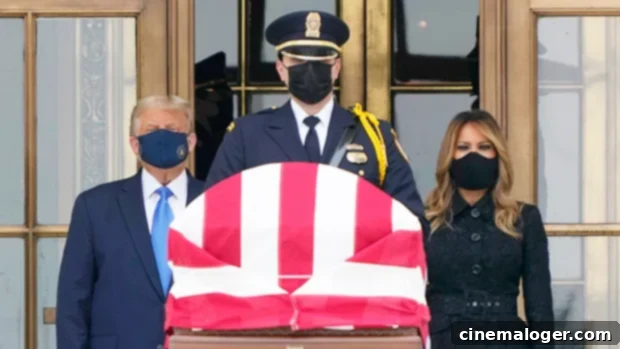President Trump Met with Boos and “Vote Him Out” Chants at Ruth Bader Ginsburg’s Supreme Court Repose
President Donald Trump’s solemn visit to the Supreme Court, intended to pay respects to the late Justice Ruth Bader Ginsburg as she lay in repose, was abruptly met with a chorus of boos and fervent chants of “vote him out.” The extraordinary scene unfolded on September 24, 2020, just days after Justice Ginsburg’s passing on September 19, transforming a moment of national mourning into a stark display of America’s deep political divisions. Accompanied by First Lady Melania Trump, the President stood in silent deference for merely a minute before turning to leave, the protesters’ impassioned cries echoing through the hallowed grounds of the Supreme Court.
The incident highlighted the raw emotions surrounding Justice Ginsburg’s death and the immediate political battle for her successor. For many mourners present, Ginsburg’s legacy represented a bulwark against conservative judicial overreach, and Trump’s presence, particularly given his vow to swiftly nominate a replacement, was seen by some as an affront. This direct, vocal opposition offered a rare, unmediated glimpse for President Trump into the sentiments of a significant portion of the American populace, underscoring the profound political stakes of the moment.
Trump at the court as crowd chants “vote him out” — it’s rare for this President to see his opposition this up-close and in-person pic.twitter.com/VEVkRHOkjM
— Kevin Liptak (@Kevinliptakcnn) September 24, 2020
A Nation Mourns: Honoring Justice Ruth Bader Ginsburg’s Unforgettable Legacy
Justice Ruth Bader Ginsburg, affectionately known as “The Notorious RBG,” was a towering figure in American jurisprudence, whose passing at the age of 87 sent shockwaves across the nation and beyond. Appointed to the Supreme Court in 1993, she dedicated 27 years to championing gender equality, civil rights, and justice for all. Her eloquent dissents and groundbreaking majority opinions reshaped American society, particularly in areas concerning women’s rights, voting rights, and healthcare. Her death left a profound void, not only on the bench but also in the hearts of millions who saw her as a tireless advocate for progress and fairness.
Ginsburg’s contributions extended far beyond her judicial rulings; she became a cultural icon, inspiring generations with her unwavering commitment to justice, her intellectual prowess, and her resilience. Her fight against cancer while remaining active on the court epitomized her strength and dedication. The outpouring of grief and tributes following her death underscored her unique status as a beacon of hope and a symbol of the enduring struggle for equality. Her legacy continues to resonate deeply, making her repose at the Supreme Court a moment of intense national reflection and profound political symbolism.
The video footage from the September 24 incident captured President Trump, unusually wearing a black protective face mask, standing beside Justice Ginsburg’s American flag-draped casket. He remained stoic, showing little overt reaction to the chants that filled the air. After approximately a minute of this tense silence, punctuated by the protesters’ shouts, he and the First Lady turned and departed. As CNN White House reporter Kevin Liptak aptly noted on Twitter, “it’s rare for this president to see his opposition this up-close and in-person,” highlighting the extraordinary nature of the confrontation and its stark departure from typical presidential protocol during such solemn occasions.
Solemn Tributes: Ginsburg Lies in Repose and State
Justice Ginsburg’s body was laid in repose at the Supreme Court, the very institution where she served with distinction for nearly three decades, beginning on September 23. The ceremony was a poignant tribute to her life and work, featuring a historic moment as a female rabbi delivered a prayer, and Chief Justice John Roberts offered a eulogy, honoring his colleague’s profound impact on American law and society. Current and former law clerks, a testament to her mentorship and influence, lined the steps of the Supreme Court in silent tribute as her casket was reverently carried by Supreme Court police officers, symbolizing the deep respect she commanded from across the legal spectrum.
Following her time at the Supreme Court, Justice Ginsburg’s casket was transported to the United States Capitol, where she became the first woman in US history to lie in state. This distinguished honor, typically reserved for presidents and a select few prominent figures, underscored the extraordinary significance of her life and contributions to the nation. Her lying in state at the Capitol provided another opportunity for the American public to pay their final respects, albeit under the shadow of a contentious political debate that had already begun to overshadow the period of mourning.

The Battle for the Supreme Court: A Swift Nomination Amidst Controversy
In the immediate aftermath of Justice Ginsburg’s death, President Trump swiftly vowed to name her replacement on the Supreme Court as quickly as possible, initiating a fierce political battle. This pronouncement was met with immediate and widespread outcry from Democrats, who argued vehemently that a new Supreme Court pick should wait until after the November 3 presidential election. Their arguments were rooted in a powerful precedent set just four years prior.
In 2016, following the death of Justice Antonin Scalia, then-President Barack Obama nominated Merrick Garland to fill the vacancy. However, Senate Majority Leader Mitch McConnell (R-KY) famously refused to allow a vote on Garland’s nomination, citing that it was an election year and the American people should have a say through their vote for president. McConnell’s stance effectively blocked Obama’s nominee for nearly a year, leaving the seat vacant until President Trump could appoint his first justice, Neil Gorsuch, after taking office. Democrats now accused McConnell and Republicans of blatant hypocrisy, arguing that the same rule should apply in 2020.
The political stakes could not have been higher. With the upcoming presidential election and the control of the Senate hanging in the balance, the nomination represented a critical opportunity for conservatives to solidify a supermajority on the Supreme Court for decades to come. This shift would have profound implications for landmark rulings on issues such as abortion rights, healthcare, voting rights, and LGBTQ+ equality. As of September 24, Republicans had quickly moved to secure enough votes in the Senate for President Trump to announce his nominee, signaling their intent to proceed with a confirmation process regardless of Democratic opposition or the approaching election.

Amy Coney Barrett: The Expected Nominee and Ideological Shift
Out of respect for the mourning period, President Trump vowed to wait until after Justice Ginsburg’s memorial services were concluded before officially announcing his nominee. However, speculation was rampant, and it was widely thought that Trump would select Amy Coney Barrett, a 48-year-old judge from the 7th US Circuit Court of Appeals. Barrett’s potential nomination immediately sparked intense debate due to her judicial philosophy and personal background, which stand in stark contrast to Justice Ginsburg’s.
Amy Coney Barrett is known for her deeply conservative judicial philosophy, often described as an “originalist” or “textualist,” meaning she interprets the Constitution based on its original meaning at the time of its adoption. This approach is fundamentally different from Justice Ginsburg’s method, which favored a living Constitution, interpreting its principles in light of contemporary society. A Barrett nomination would represent a dramatic ideological shift on the Supreme Court, replacing a liberal champion of women’s rights and individual liberties with an ultra-conservative justice whose past statements and judicial record suggest opposition to abortion rights, same-sex marriage, and expansive interpretations of federal power.
Further intensifying the controversy surrounding Barrett was her association with People of Praise, a charismatic Christian group that has drawn scrutiny for its hierarchical structure and gender roles, often referred to as “headships” and “handmaidens.” This connection gained particular public attention due to its perceived similarities to the dystopian society depicted in Margaret Atwood‘s seminal novel, The Handmaid’s Tale. Critics raised concerns about how such affiliations might influence her judicial impartiality, especially on issues related to religious freedom, women’s autonomy, and LGBTQ+ rights, igniting a fierce debate over the role of personal faith in judicial decision-making and the future direction of the Supreme Court.
Public Reaction and the Future of the Court
The highly charged political atmosphere surrounding Justice Ginsburg’s death and the ensuing Supreme Court vacancy was palpable, with the public reacting in various ways. Protests like the one witnessed at the Supreme Court were echoed in demonstrations across the country, as citizens expressed their anguish over Ginsburg’s passing and their fears about the future of the court. Media coverage intensified, with every move by the White House and Senate Republicans scrutinized, while legal scholars and political pundits debated the historical precedents, constitutional norms, and potential consequences of a rushed confirmation.
The decision to push through a Supreme Court nomination so close to a presidential election, especially after the precedent set in 2016, raised serious questions about the legitimacy and perceived political impartiality of the nation’s highest court. Many feared that such an overtly partisan maneuver would further erode public trust in the judiciary, transforming the Supreme Court into yet another battleground for political power rather than a body dedicated to impartial justice. The long-term impact of this moment—on judicial independence, constitutional interpretation, and the delicate balance of powers—remains a subject of intense national concern.
Ultimately, the boos and chants that greeted President Trump at Justice Ginsburg’s repose encapsulated a nation grappling with profound political divides and monumental decisions. It was a stark reminder that even in moments of national mourning, the deep ideological chasm within American society could not be set aside. The battle over Justice Ginsburg’s successor was not merely about a judicial appointment; it was a struggle for the soul of the Supreme Court and the very future direction of American law and values.
